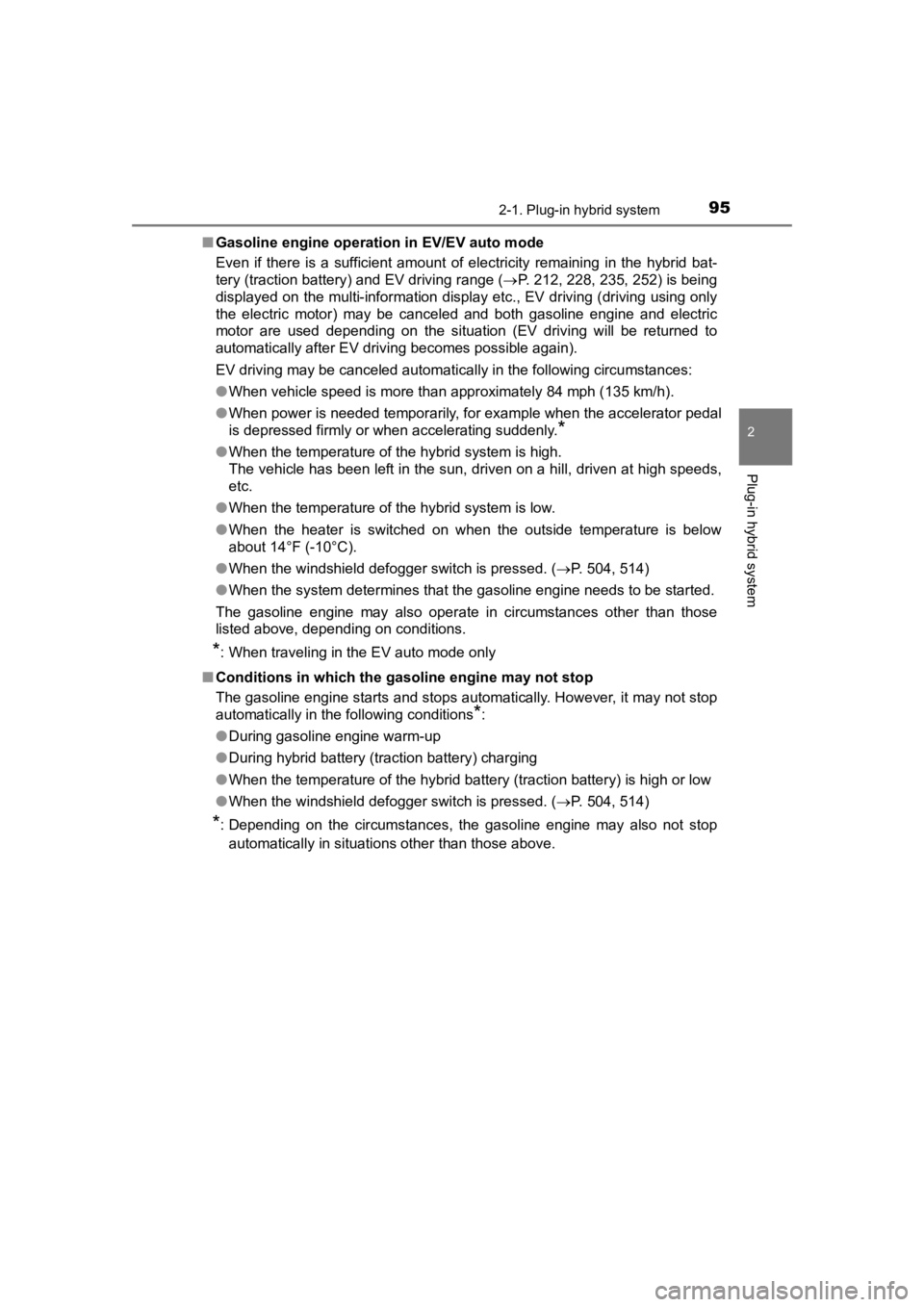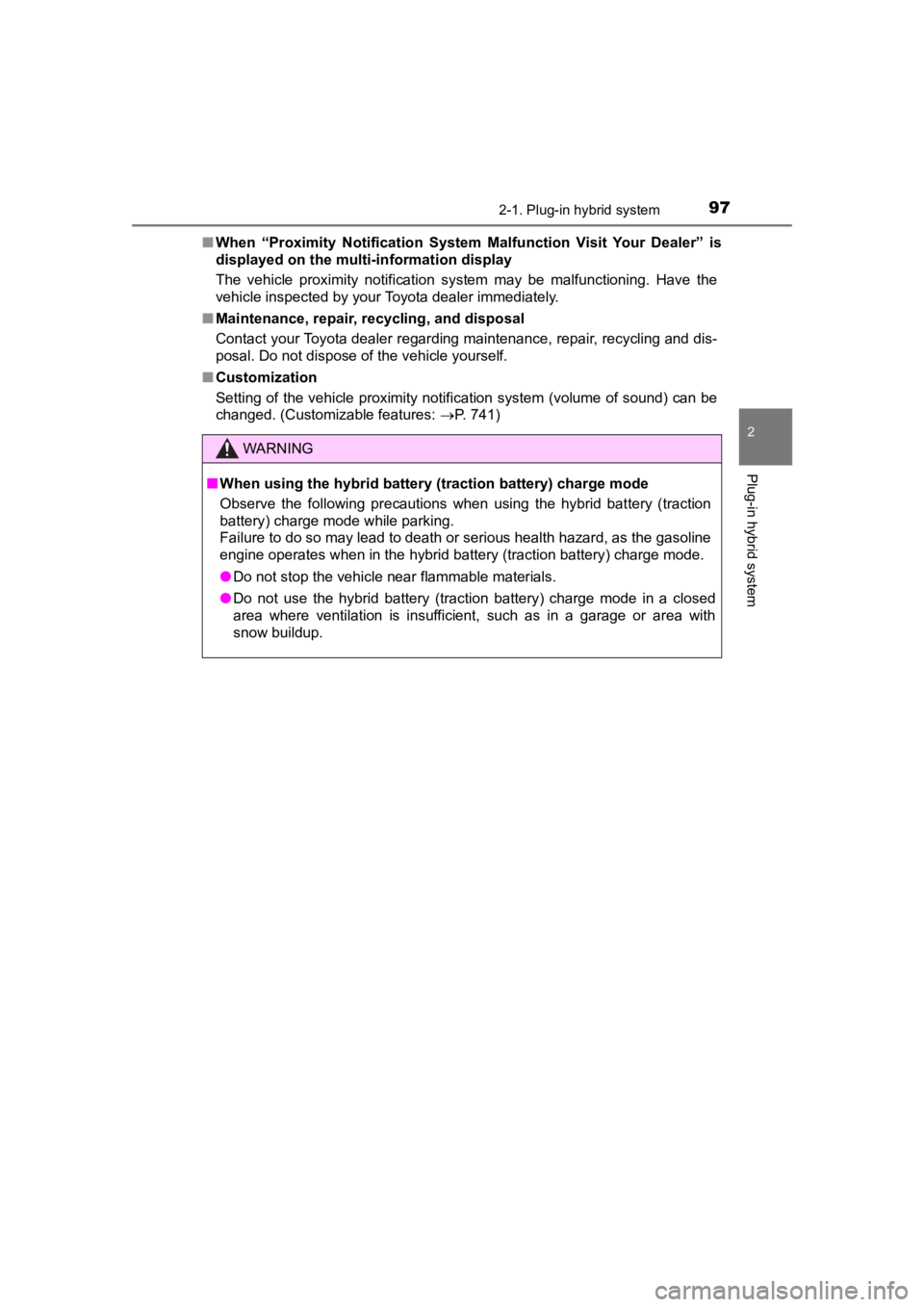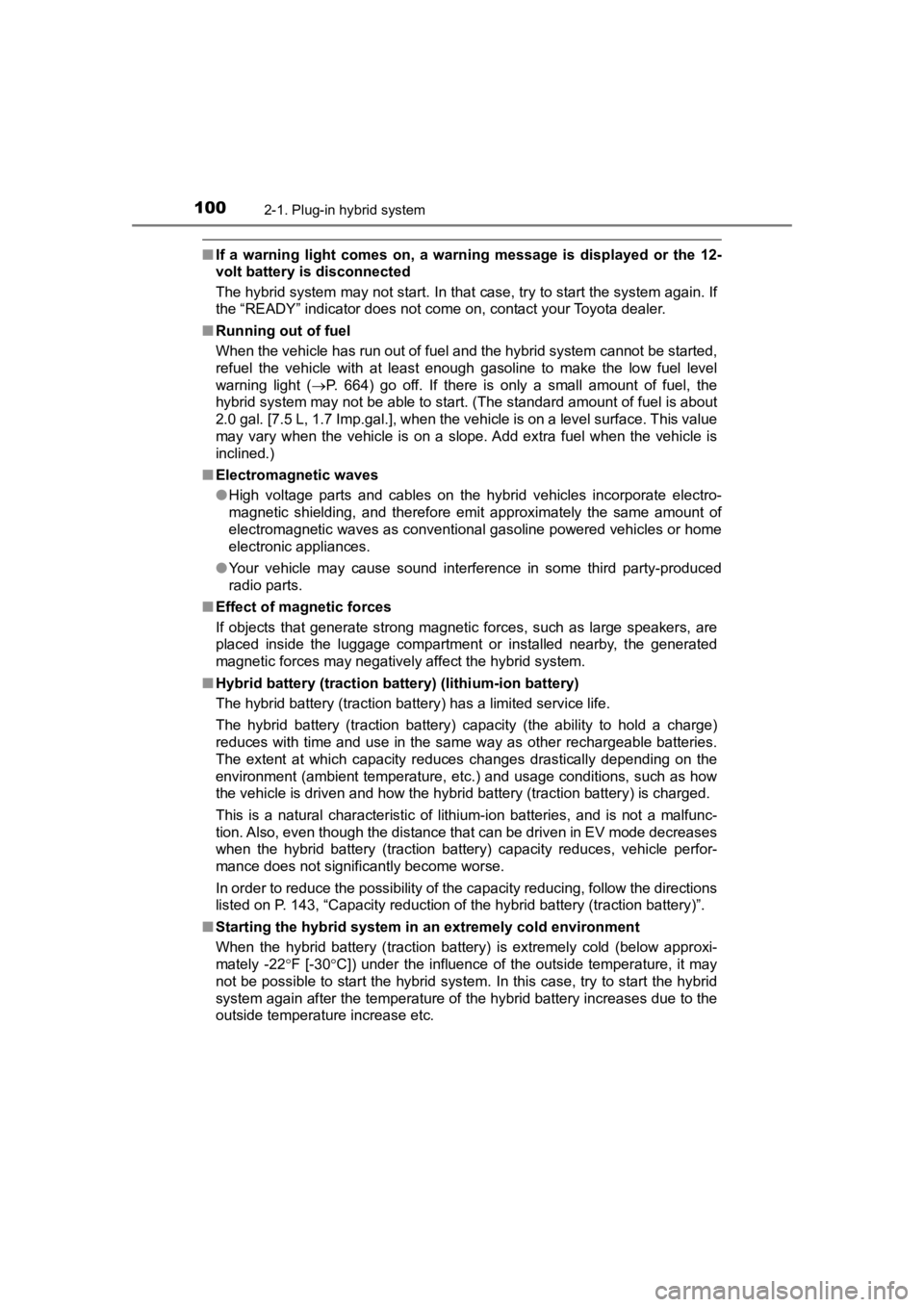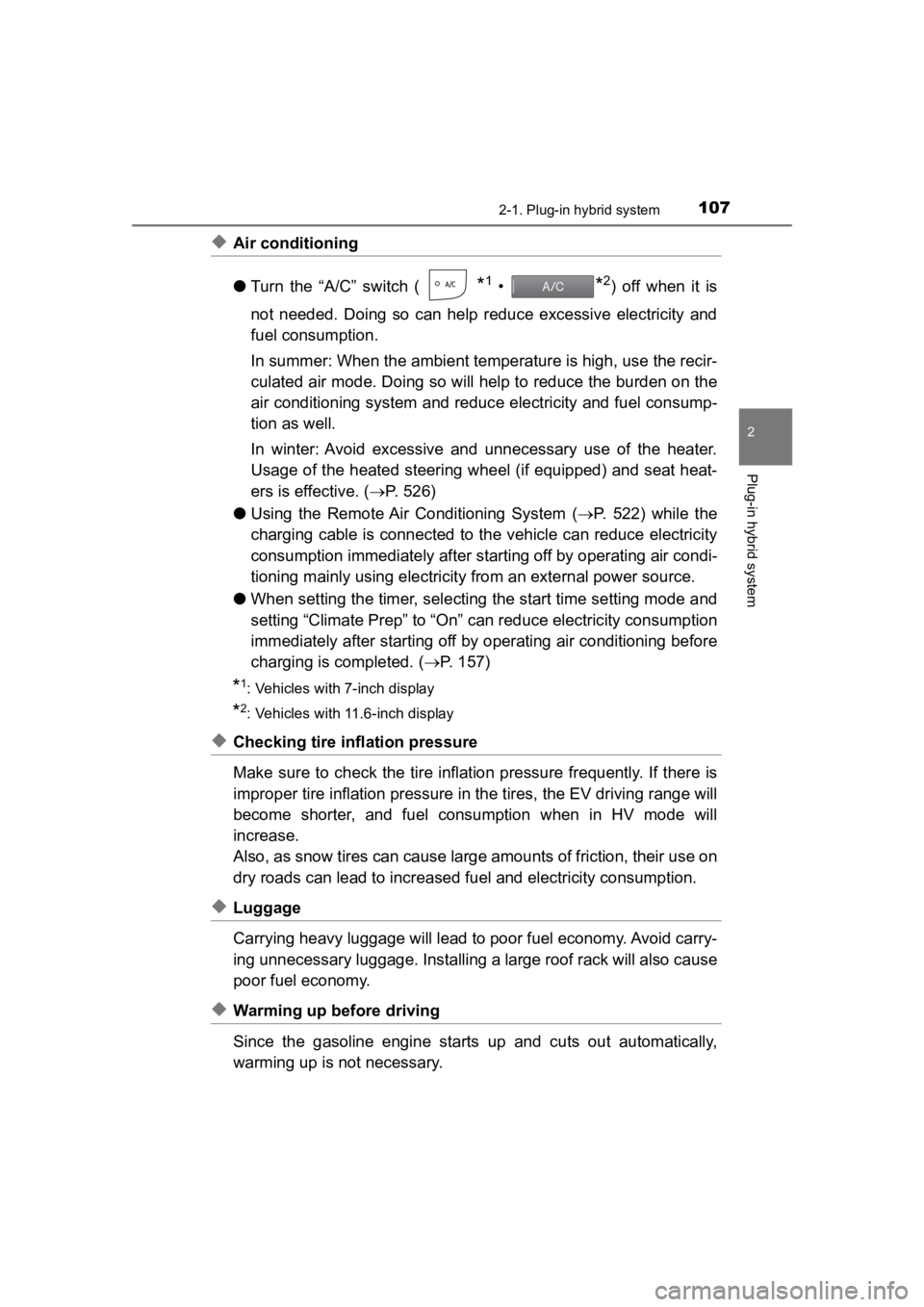2020 TOYOTA PRIUS PRIME display
[x] Cancel search: displayPage 91 of 792

PRIUS PRIME_OM_OM47C77U_(U)
912-1. Plug-in hybrid system
2
Plug-in hybrid system
■Switching to the hybrid battery (traction battery) charge mode
Press and hold the switch.
Take your hand off the switch
once the hybrid battery charge
mode indicator starts to blink.
The hybrid battery charge mode
indicator illuminates when the
switch to hybrid battery (traction
battery) charge mode is com-
plete.
When the hybrid battery (traction battery) is fully charged
*, the hybrid
battery (traction battery) charge mode is automatically cancele d and the
operation mode will be switched to HV mode.
The hybrid battery (traction battery) charge mode will be cance led by
pressing EV/HV mode selection switch or EV auto mode switch.
*: The maximum charge amount in the hybrid battery (traction batt ery)
charge mode is approximately 80% of the fully charged capacity for the
charging from an external power source.
■ If the plug-in hybrid system ope ration mode cannot be changed
In the following situations, the plug-in hybrid system operation mode cannot
be changed even if the EV/HV mode selection switch or EV auto mode switch
is pressed. (In this case, the warning message is displayed on the multi-infor-
mation display when the switch is pressed.)
● When electricity needed for EV driving is not remaining (when in EV/EV
auto mode)
● When the traction battery is almost completely charged (hybrid battery [trac-
tion battery] charge mode)
■ When switching from EV mode to another mode using the switch
When the power switch is turned of f, operation mode switching is canceled
and the system returns to EV mode the next time the vehicle is started.
■ Hybrid battery (traction battery) charge mode
●The following may occur to protect the system, etc.
• Cannot switch to hybrid battery (traction battery) charge mode or cannot
cancel it
• Gasoline engine does not start or stops even after switching to hybrid bat- tery (traction battery) charge mode
● If a load to the system is large, such as when the power consumption of the
air conditioning system is large or when the temperature of the engine cool-
ant is high, it may take longer time than usual to charge using the hybrid bat-
tery (traction battery) charge mode, or charging to the hybrid battery
(traction battery) may not be performed.
Page 94 of 792

94
PRIUS PRIME_OM_OM47C77U_(U)
2-1. Plug-in hybrid system
■Regenerative braking
In the following situations, kinetic energy is converted to electric energy and
deceleration force can be obtained in conjunction with the rech arging of the
hybrid battery (traction battery).
● The accelerator pedal is released while driving with the shift position in D or
B.
● The brake pedal is depressed while driving with the shift posit ion in D or B.
■ EV driving range
●The EV driving range is displayed on the multi-information disp lay etc.
( P. 212, 228, 235, 252)
● The EV driving range changes in accordance with the charge status of the
hybrid battery (traction battery), the speed of the vehicle, et c.
● Even if there is enough charge remaining in the hybrid battery (traction bat-
tery), EV driving may be canceled and both gasoline engine and electric
motor are used depending on the situation. ( P. 95)
■ After EV mode has switched to HV mode due to low hybrid battery (trac-
tion battery) charge
If the hybrid battery (traction battery) is regenerated by driving continuously
down a long slope, the EV driving range etc. will be displayed on the multi-
information display and EV mode will be automatically switched to.
If EV mode is not switched to even though EV driving range is b eing dis-
played, EV mode can be switched to by pressing the EV/HV mode selection
switch.
■ Refilling fuel
Plug-in hybrid vehicles can be driven using electricity charged from an exter-
nal power source. However, as the gasoline engine is used depending on the
situation even if in EV mode, and the gasoline engine is provided on board as
a power source for driving in HV mode, it is needed to refuelin g the vehicle.
Check the fuel amount and refill immediately when the fuel level becomes
low. ( P. 368)
Page 95 of 792

PRIUS PRIME_OM_OM47C77U_(U)
952-1. Plug-in hybrid system
2
Plug-in hybrid system
■Gasoline engine operation in EV/EV auto mode
Even if there is a sufficient amount of electricity remaining in the hybrid bat-
tery (traction battery) and EV driving range ( P. 212, 228, 235, 252) is being
displayed on the multi-information display etc., EV driving (dr iving using only
the electric motor) may be canceled and both gasoline engine an d electric
motor are used depending on the situation (EV driving will be returned to
automatically after EV driving becomes possible again).
EV driving may be canceled automatically in the following circu mstances:
● When vehicle speed is more than approximately 84 mph (135 km/h) .
● When power is needed temporarily, for example when the accelera tor pedal
is depressed firmly or when accelerating suddenly.
*
● When the temperature of the hybrid system is high.
The vehicle has been left in the sun, driven on a hill, driven at high speeds,
etc.
● When the temperature of the hybrid system is low.
● When the heater is switched on when the outside temperature is below
about 14°F (-10°C).
● When the windshield defogger switch is pressed. ( P. 504, 514)
● When the system determines that the gasoline engine needs to be started.
The gasoline engine may also operate in circumstances other tha n those
listed above, depending on conditions.
*: When traveling in the EV auto mode only
■ Conditions in which the gasoline engine may not stop
The gasoline engine starts and stops automatically. However, it may not stop
automatically in the following conditions
*:
● During gasoline engine warm-up
● During hybrid battery (traction battery) charging
● When the temperature of the hybrid battery (traction battery) is high or low
● When the windshield defogger switch is pressed. ( P. 504, 514)
*: Depending on the circumstances, the gasoline engine may also not stop
automatically in situations other than those above.
Page 97 of 792

PRIUS PRIME_OM_OM47C77U_(U)
972-1. Plug-in hybrid system
2
Plug-in hybrid system
■When “Proximity Notification System Malfunction Visit Your Deal er” is
displayed on the multi-information display
The vehicle proximity notification system may be malfunctioning. Have the
vehicle inspected by your Toyota dealer immediately.
■ Maintenance, repair, recycling, and disposal
Contact your Toyota dealer regarding maintenance, repair, recyc ling and dis-
posal. Do not dispose of the vehicle yourself.
■ Customization
Setting of the vehicle proximity notification system (volume of sound) can be
changed. (Customizable features: P. 741)
WARNING
■When using the hybrid battery ( traction battery) charge mode
Observe the following precautions when using the hybrid battery (traction
battery) charge mode while parking.
Failure to do so may lead to death or serious health hazard, as the gasoline
engine operates when in the hybrid battery (traction battery) charge mode.
● Do not stop the vehicle near flammable materials.
● Do not use the hybrid battery (traction battery) charge mode in a closed
area where ventilation is insufficient, such as in a garage or area with
snow buildup.
Page 99 of 792

PRIUS PRIME_OM_OM47C77U_(U)
992-1. Plug-in hybrid system
2
Plug-in hybrid system
There are air intake vents on both
sides of the rear seatback for the
purpose of cooling the hybrid bat-
tery (traction battery). If the vents
are blocked, charging/discharg-
ing of the hybrid battery (traction
battery) may become limited.
When a certain level of impact is detected by the impact sensor , the
emergency shut off system block s off the high voltage current and
stops the fuel pump to minimize the risk of electrocution and f uel leak-
age. If the emergency shut off s ystem activates, your vehicle will not
restart. To restart the hybrid s ystem, contact your Toyota deal er.
A message is automatically displ ayed when a malfunction occurs in
the hybrid system or an improper operation is attempted.
If a warning message is shown on
the multi-information display, read
the message and follow the
instructions.
Hybrid battery (traction battery) air vents
Emergency shut off system
Hybrid warning message
Page 100 of 792

100
PRIUS PRIME_OM_OM47C77U_(U)
2-1. Plug-in hybrid system
■If a warning light comes on, a warning message is displayed or the 12-
volt battery is disconnected
The hybrid system may not start. In that case, try to start the system again. If
the “READY” indicator does not come on, contact your Toyota dea ler.
■ Running out of fuel
When the vehicle has run out of fuel and the hybrid system cann ot be started,
refuel the vehicle with at least enough gasoline to make the lo w fuel level
warning light ( P. 664) go off. If there is only a small amount of fuel, the
hybrid system may not be able to start. (The standard amount of fuel is about
2.0 gal. [7.5 L, 1.7 Imp.gal.], when the vehicle is on a level surface. This value
may vary when the vehicle is on a slope. Add extra fuel when th e vehicle is
inclined.)
■ Electromagnetic waves
●High voltage parts and cables on the hybrid vehicles incorporat e electro-
magnetic shielding, and therefore emit approximately the same amount of
electromagnetic waves as conventional gasoline powered vehicles or home
electronic appliances.
● Your vehicle may cause sound interference in some third party-p roduced
radio parts.
■ Effect of magnetic forces
If objects that generate strong magnetic forces, such as large speakers, are
placed inside the luggage compartment or installed nearby, the generated
magnetic forces may negatively affect the hybrid system.
■ Hybrid battery (traction batt ery) (lithium-ion battery)
The hybrid battery (traction battery) has a limited service lif e.
The hybrid battery (traction battery) capacity (the ability to hold a charge)
reduces with time and use in the same way as other rechargeable batteries.
The extent at which capacity reduces changes drastically depending on the
environment (ambient temperature, etc.) and usage conditions, such as how
the vehicle is driven and how the hybrid battery (traction batt ery) is charged.
This is a natural characteristic of lithium-ion batteries, and is not a malfunc-
tion. Also, even though the distance that can be driven in EV m ode decreases
when the hybrid battery (traction battery) capacity reduces, ve hicle perfor-
mance does not significantly become worse.
In order to reduce the possibility of the capacity reducing, fo llow the directions
listed on P. 143, “Capacity reduction of the hybrid battery (tr action battery)”.
■ Starting the hybrid system in a n extremely cold environment
When the hybrid battery (traction battery) is extremely cold (b elow approxi-
mately -22 F [-30C]) under the influence of the outside temperature, it may
not be possible to start the hybrid system. In this case, try to start the hybrid
system again after the temperature of the hybrid battery increases due to the
outside temperature increase etc.
Page 104 of 792

104
PRIUS PRIME_OM_OM47C77U_(U)
2-1. Plug-in hybrid system
NOTICE
■Hybrid battery (traction battery) air vents
● Make sure not to block the air intake vent with anything, such as a seat
cover, plastic cover, or luggage. If the vents are blocked, the charging/dis-
charging of the hybrid battery (traction battery) may become limited.
● When dust etc. has accumulated in the air intake vent, clean it with a vac-
uum cleaner to prevent the vent from clogging.
● Do not wet or allow foreign substances to enter the air vents a s this may
cause a short circuit and damage the hybrid battery (traction battery).
● Do not carry large amounts of water such as water cooler bottle s in the
vehicle. If water spills onto the hybrid battery (traction batt ery), the battery
may be damaged. Have the vehicle inspected by your Toyota deale r.
● A filter is installed to the air intake vent. When the filter remains noticeably
dirty even after cleaning the air intake vent, filter cleaning or replacement
is recommended. When cleaning the filter, refer to P. 570.
■ Notice about fuel
● For plug-in hybrid vehicles, fuel may remain in the tank for a long time and
undergo changes in quality depending on the how the vehicle is used.
Refuel at least 5.3 gal. (20 L, 4.4 Imp.gal.) of fuel every 12 months (refuel
a total of at least 5.3 gal. [20 L, 4.4 Imp.gal.] over a 12-mon th period), as
this may affect components of the fuel system or the gasoline engine.
● If the vehicle has not been refueled for a certain amount of time and it is
possible that the quality of the fuel remaining in the tank has changed, “No
new fuel has been added recently. Please refuel” is displayed on the multi-
information display when the power switch is turned to ON mode. If the
message is displayed, refuel the vehicle immediately.
Page 107 of 792

PRIUS PRIME_OM_OM47C77U_(U)
1072-1. Plug-in hybrid system
2
Plug-in hybrid system
◆Air conditioning
●Turn the “A/C” switch (
*1 • *2) off when it is
not needed. Doing so can help reduce excessive electricity and
fuel consumption.
In summer: When the ambient temperature is high, use the recir-
culated air mode. Doing so will help to reduce the burden on th e
air conditioning system and reduc e electricity and fuel consump-
tion as well.
In winter: Avoid excessive and unnecessary use of the heater.
Usage of the heated steering w heel (if equipped) and seat heat-
ers is effective. ( P. 5 2 6 )
● Using the Remote Air Conditioning System ( P. 522) while the
charging cable is connected to the vehicle can reduce electrici ty
consumption immediately after st arting off by operating air condi-
tioning mainly using electricity from an external power source.
● When setting the timer, selecting the start time setting mode a nd
setting “Climate Prep” to “On” c an reduce electricity consumption
immediately after starting off by operating air conditioning be fore
charging is completed. ( P. 157)
*1: Vehicles with 7-inch display
*2: Vehicles with 11.6-inch display
◆Checking tire inflation pressure
Make sure to check the tire inflation pressure frequently. If t here is
improper tire inflation pressur e in the tires, the EV driving range will
become shorter, and fuel consumption when in HV mode will
increase.
Also, as snow tires can cause large amounts of friction, their use on
dry roads can lead t o increased fuel and electricity consumptio n.
◆Luggage
Carrying heavy luggage will lead to poor fuel economy. Avoid carry-
ing unnecessary luggage. Installing a large roof rack will also cause
poor fuel economy.
◆Warming up before driving
Since the gasoline engine starts up and cuts out automatically,
warming up is not necessary.